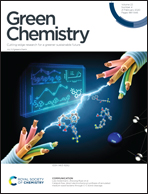Recycling non-food-grade tree gum wastes into nanoporous carbon for sustainable energy harvesting†
Abstract
The disposal of natural wastes has become a global problem and the use of lower-grade gums is very limited owing to their impurities as well as sticky nature. Rather than disposing these wastes, nanoporous carbon (nC) has instead been synthesized by carbonization and exfoliation. The synthesized nC exhibits a substantially high surface area along with abundant micro/mesopores. This desirable and useful nature of nC is well-suited for water-driven effective electrical energy conversion, which enables the fast evaporation of water via a capillary action through nanopores. Under asymmetric wetting in a water container and ambient conditions, the nC-based energy harvesters showed high capability of electricity production and reliable output generation, easily turning on a blue light-emitting diode (2.5 V and 20 mA) using a stored power source. In summary, many energy harvesters can be manufactured for the scale-up of electricity, and the suitability of regenerated carbon nanomaterials for green energy harvesting can contribute toward alleviating chronic environmental issues.

- This article is part of the themed collection: 2020 Green Chemistry Hot Articles


 Please wait while we load your content...
Please wait while we load your content...